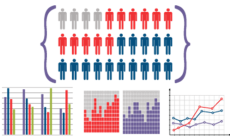

What is epidemiology?
Epidemiology is the study of diseases within populations, used for looking at current trends, identifying risk factors and making predictions for the future. Epidemiologists use a lot of modelling and statistics to show the spread of disease.
From an epidemiological study we can ask, what is the likely cause of disease? Once we have established the cause, we can then look for risk factors, these are factors which increase a person’s likelihood of certain getting a disease. For example, a common risk factor for cancer is smoking. Ultimately, epidemiologists aim to understand a disease, how to reduce its prevalence, and then we want to actually reduce it!
For the epidemiologic approach, we look for an association between exposure to variables and development of disease. Exposure could be for example, has a person consumed a high cholesterol diet, or high sugar diet? We need to then look at the people with a disease who have not been exposed, let’s make a comparison. Is there a higher risk of developing disease when exposure? Why have these observations occurred? Can we prevent or control the development of this disease?
As the population as a whole is very large, and complex, we need to study target populations; these are our populations of interest. For example, for a study on cancer, we could firstly just look at women at risk of developing breast cancer, in the UK only. We might want to make the group even smaller by targeting a certain age group. Whilst it is important to not let our numbers get too low, we want to be able to do a thorough study of the population, this requires time, money and trained scientists. Typically studies will be defined by age, race, sex, and their geographical location, it is important for it to be representative of the target population.
In epidemiology, disease is quantified. Rate refers to how fast the disease is occurring, so is discussed over a specified period of time. Proportions are fractions of the population affected. Incidence is a rate, whilst prevalence is a proportion. Incidence shows us the number of new disease cases within a period of time. Prevalence shows us how much disease there is in a population at any one time. There are two types of prevalence, point and period. Point prevalence as the name may suggest refers to one to point in time. For example, do you currently have diabetes? Period prevalence is the amount of disease in a period of time, for example, have you had the flu in the past 5 years? Prevalence is very much dependent on incidence and how long the disease lasts. A disease may not last due to either death or recovery.
Variables are factors we are interested in, and well, they vary! If we know a variable can affect results, but we are not studying that variable in particular, we need to control it, these are called controls. For example, we may do a single sex study as there is variation between genders. Some variables influence other variables, these are called dependent variables. Our independent variables are variables that alter our dependent variables, a common one you may have used in school is time. And this is just the beginning of a study…
Image- https://toxtutor.nlm.nih.gov/05-003.html

0 Comment:
Be the first one to comment on this article.